2017 MERCEDES-BENZ E43AMG IDENTIFICATION
[x] Cancel search: IDENTIFICATIONPage 354 of 482
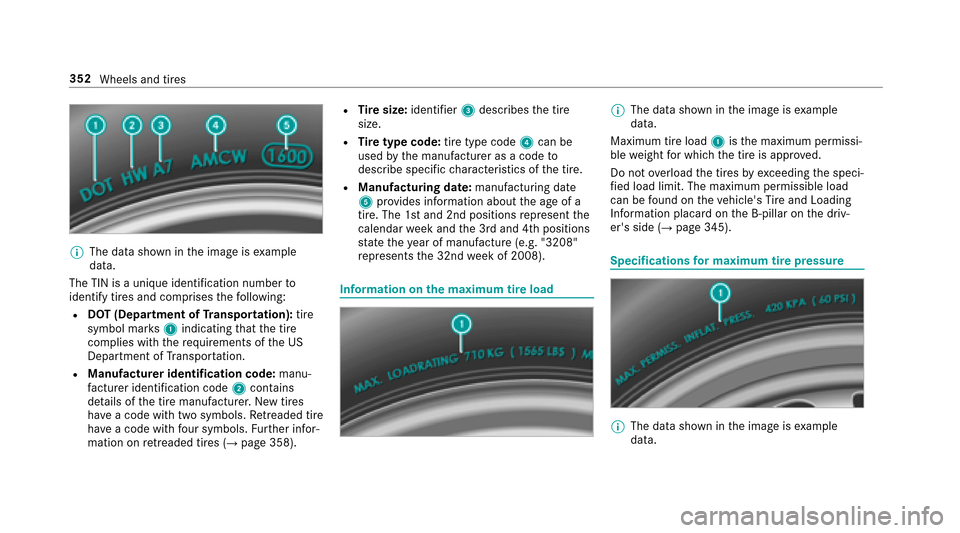
%The data shown in the image is example
data.
The TIN is a unique identification number to
identify tires and comprises thefo llowing:
RDOT (Department of Transport ation):tire
symbol mar ks1 indicating that the tire
complies with therequ irements of the US
Department of Transpor tation.
RManufacturer identi fication code: manu‐
fa cturer identification code 2contains
de tails of the tire manufacturer. New tires
ha ve a code with two symbols. Retreaded tire
ha ve a code with four symbols. Further infor‐
mation on retreaded tires (
→pa ge 358).
RTire size: identifier 3describes the tire
size.
RTi re type code: tire type code 4can be
used bythe manufacturer as a code to
describe specific characteristics of the tire.
RManufacturing date: manufacturing date
5 prov ides information about the age of a
tire. The 1st and 2nd positions represent the
calendar week and the 3rd and 4th positions
st ate theye ar of manufacture (e.g. "3208"
re presents the 32nd week of 2008).
Information on the maximum tire load
%
The data shown in the image is example
data.
Maximum tire load 1isthe maximum permissi‐
ble weight for which the tire is appr oved.
Do not overload the tires by exceeding the speci‐
fi ed load limit. The maximum permissible load
can be found on theve hicle's Tire and Loading
Info rmation placard on the B-pillar on the driv‐
er's side (
→page 345).
Specifications for maximum tire pressure
%
The da tashown in the image is example
data.
352 Wheels and tires
Page 358 of 482
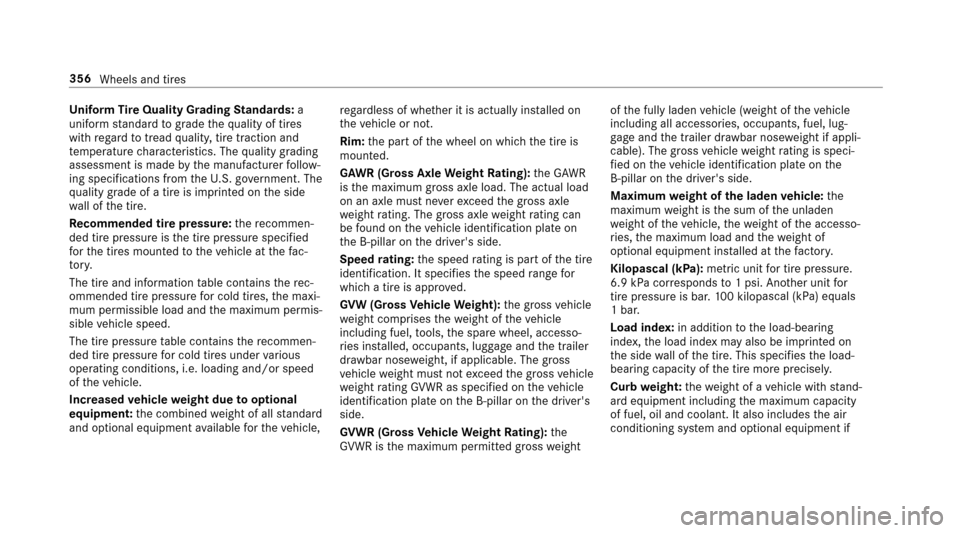
Uniform Tire Quality Grading Standards: a
uniform standard tograde thequ ality of tires
with rega rd totread quality, tire traction and
te mp erature characteristics. The quality grading
assessment is made bythe manufacturer follow‐
ing specifications from theU. S. go vernment. The
qu ality grade of a tire is imprinted on the side
wa ll of the tire.
Re commended tire pressure :th ere commen‐
ded tire pressure is the tire pressure specified
fo rth e tires mounted totheve hicle at thefa c‐
to ry.
The tire and information table conta insthere c‐
ommended tire pressure for cold tires, the maxi‐
mum permissible load and the maximum permis‐
sible vehicle speed.
The tire pressure table conta insthere commen‐
ded tire pressure for cold tires under various
operating conditions, i.e. loading and/or speed
of theve hicle.
Increased vehicle weight due tooptional
equipment: the combined weight of all standard
and optional equipment available forth eve hicle, re
ga rdless of whe ther it is actually ins talled on
th eve hicle or not.
Rim: the part of the wheel on which the tire is
mounted.
GA WR (Gross Axle Weight Rating): the GAWR
is the maximum gross axle load. The actual load
on an axle must ne verexc eed the gross axle
we ight rating. The gross axl e
we ight rati
ng can
be found on theve hicle identification plate on
th e B‑pillar on the driver's side.
Speed rating: the speed rating is pa rtof the tire
identification. It specifies the speed range for
which a tire is appr oved.
GV W (Gross Vehicle Weight): the gross vehicle
we ight comprises thewe ight of theve hicle
including fuel, tools, the spare wheel, accesso‐
ri es ins talled, occupants, luggage and the trailer
dr aw bar nose weight, if applicable. The gross
ve hicle weight must not exceed the gross vehicle
we ight rating GVWR as specified on theve hicle
identification plate on the B‑pillar on the driver's
side.
GV WR (Gross Vehicle Weight Rating): the
GV WR is the maximum permitted gross weight of
the fully laden vehicle (weight of theve hicle
including all accessories, occupants, fuel, lug‐
ga ge and the trailer dr awbar nose weight if appli‐
cable). The gross vehicle weight rating is speci‐
fi ed on theve hicle identification plate on the
B‑pillar on the driver's side.
Maximum weight of the laden vehicle: the
maximum weight is the sum of the unladen
we ight of theve hicle, thewe ight of the accesso‐
ri es, the maximum load and thewe ight of
optional equipment ins talled at thefa ctor y.
Kilopascal (kPa): metricunit for tire pressure .
6.9 kPa cor responds to1 psi. Ano ther unit for
tire pressure is bar.100 kilop ascal (kPa
) equals
1 bar.
Load index: in additiontothe load-bearing
index, the load index may also be imprinted on
th e side wall of the tire. This specifies the load-
bearing capacity of the tire more precisel y.
Curb weight: thewe ight of a vehicle with stand‐
ard equipment including the maximum capacity
of fuel, oil and coolant. It also includes the air
conditioning sy stem and optional equipment if
356
Wheels and tires
Page 359 of 482
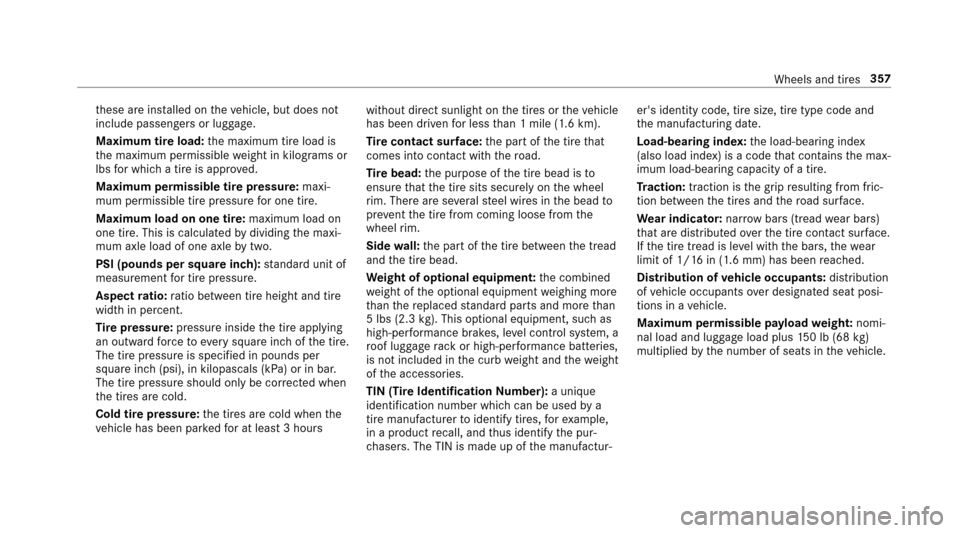
these are ins talled on theve hicle, but does not
include passengers or luggage.
Maximum tire load: the maximum tire load is
th e maximum permissible weight in kilog rams or
lbs for which a tire is appr oved.
Maximum permissible tire pressure: maxi‐
mum permissible tire pressure for one tire.
Maximum load on one tire: maximum load on
one tire. This is calculated bydividing the maxi‐
mum axle load of one axle bytwo.
PSI (pounds per square in ch):standard unit of
measurement for tire pressure .
Aspect ratio: ratio between tire height and tire
width in pe rcent.
Ti re pressure: pressure inside the tire applying
an outward forc eto eve rysquare inch of the tire.
The tire pressure is specified in pounds per
square inch (psi), in kilopascals (kPa) or in bar.
The tire pressure should only be cor rected when
th e tires are cold.
Cold tire pressure: the tires are cold when the
ve hicle has been par kedfo r at least 3 hours without direct sunlight on
the tires or theve hicle
has been driven for less than 1 mile (1.6 km).
Ti re contact sur face: the part of the tire that
comes into con tact wi th thero ad.
Ti re bead: the purpose of the tire bead is to
ensure that the tire sits securely on the wheel
ri m. There are se veralst eel wires in the bead to
pr eve nt
the t
ire from coming loose from the
wheel rim.
Side wall:the part of the tire between the tread
and the tire bead.
We ight of optional equipment: the combined
we ight of the optional equipment weighing more
th an there placed standard parts and more than
5 lbs (2.3 kg).This optional equipment, such as
high-per form ance brakes, le vel control sy stem, a
ro of luggage rack or high-per form ance batte ries,
is not included in the curb weight and thewe ight
of the accessories.
TIN (Tire Identification Number): a unique
identification number which can be used bya
tire manufactu rerto identify tires, forex ample,
in a product recall, and thus identify the pur‐
ch asers. The TIN is made up of the manufactur‐ er's identity code, tire size, tire type code and
th
e manufacturing date.
Load-bearing index: the load-bearing index
(also load index) is a code that con tains the max‐
imum load-bearing capacity of a tire.
Tr action: traction is the grip resulting from fric‐
tion between the tires and thero ad sur face.
We ar indicator: narrow bars (tread wear bars)
th at are distributed overth e tire conta ct surface.
If th e tire tread is le vel with the bars, thewe ar
limit of 1/ 16in (1.6 mm) has been reached.
Distribution of vehicle occupants: distribution
of vehicle occupants
over design
ated seat posi‐
tions in a vehicle.
Maximum permissible pa yload weight: nomi‐
nal load and luggage load plus 150 lb (68 kg)
multiplied bythe number of seats in theve hicle.
Wheels and tires 357
Page 372 of 482
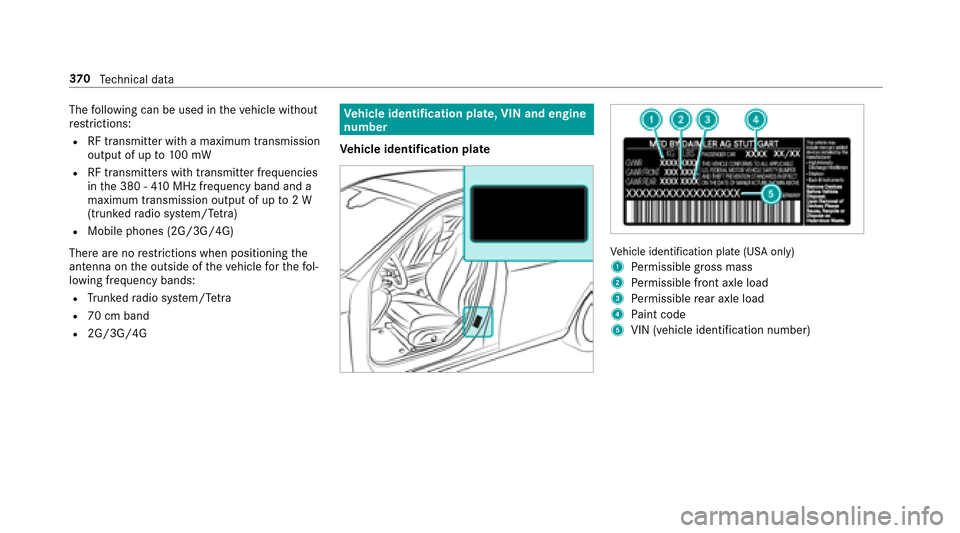
Thefollowing can be used in theve hicle without
re strictions:
RRF transmitter wi tha maximum transmission
output of up to100 mW
RRF transmitters with transmitter frequencies
inthe 380 - 410 MHz frequency band and a
maximum transmission output of up to2 W
(trunked radio sy stem/T etra )
RMobile phones (2G/3G/4G)
There are no restrictions when positioning the
antenna on the outside of theve hicle forth efo l‐
lowing frequency bands:
RTr unked radio sy stem/T etra
R70 cm band
R2G/3G/4G
Ve hicle identification plate, VIN and engine
number
Ve hicle identification plate
Vehicle identification plate (USA only)
1
Pe rm issible grossmass
2Pe rm issible front axle load
3Perm issible rear axle load
4Pa int code
5VIN (vehicle identification number)
37 0
Tech nical da ta
Page 373 of 482
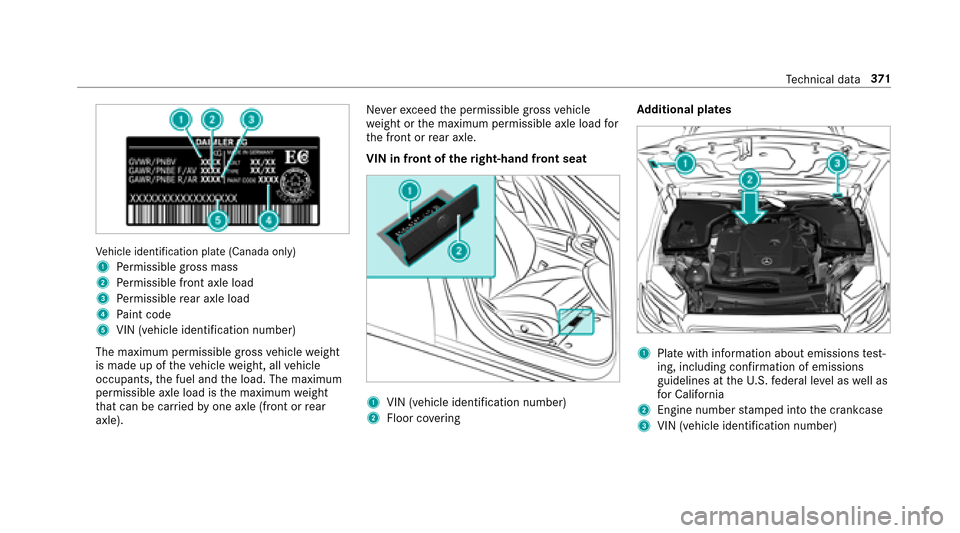
Vehicle identification plate (Canada only)
1
Pe rm issible grossmass
2Pe rm issible front axle load
3Perm issible rear axle load
4Pa int code
5VIN (vehicle identification number)
The maximum permissible gross vehicle weight
is made up of theve hicle weight, all vehicle
occupants, the fuel and the load. The maximum
permissible axle load is the maximum weight
th at can be car ried byone axle (front or rear
axle). Ne
verexc eed the permissible gross vehicle
we ight or the maximum permissible axle load for
th e front or rear axle.
VIN in front of theright-hand front seat
1VIN (vehicle identification number)
2Floor co vering Ad
ditional plates
1Pla tewith information about emissions test‐
ing, including con firm ation of emissions
guidelines at theU. S. federal le vel as well as
fo r California
2Engine number stamped into the crankcase
3VIN (vehicle identification number)
Te ch nical da ta37
1
Page 454 of 482

ÐSteering Malfunction Stop
Immediately See Operator's Manual ....418
St eering Pilot Cur rently Unavailable
See Operator's Manual ........................ 403
St eering Pilot Inoperative .................... 403
St op Vehicle Lea veEngine Running
Wa itTransmission Cooling ...................417
#St opVehicle Lea veEngine Run‐
ning ..................................................... 408
#St opVehicle See Operator's
Manual ................................................ 407
ÉSt opVehicle Vehicle Too Low ...... 398
bSwitch Off Lights .........................422
bSwitch On Headlamp s................. 422
Ti re Press. Monitor Cur rently
Un available .......................................... .411
Ti re Press. Monitor Inoperative ............412
Ti re Pressure Monitor Inoperative No
Wheel Sensors .....................................4 12
Ti re s Overheated ..................................4 12Ti
re s Overheated Decrease Speed .......413
To Deselect P or N,Dep ress Brake
and Start Engine .................................. 415
Tr af fic Sign Assist CameraView
Re stricted See Ope rator's Manual .......400
Tr af fic Sign Assist Currently Unavail‐
able See Operator's Manual ................ 403
Tr af fic Sign Assist Inoper
ative............. 403
Tr an
smission Malfunction Stop ............ 416
FTu rnOn the Ignition to Release
th ePa rking Brake ................................ 386
dVe hicle Operational Switch the
Ignition Off Before Exiting ....................416
ÉVe hicle Rising Please Wait.......... .397
ÉVe hicle Rising .............................. 397
hWa rning Tire Malfunction .............411
hWheel Sensor(s) Missing ..............412
Distance cont rol
see Dis tance Pilot DISTRONIC Di
stance Pilot DISTRONIC ...................... .161
Ac tivating ............................................ 164
Ac tivation conditions ........................... 164
Callin g up a speed .............................. .164
Deactivating ........................................ 164
Fu nction ............................................... 161
Le ver ................................................... 164
Setting a speed ................................... 164
St oring a speed ................................... 164
Sy stem limits ....................................... 161
Distance recorder .................................. .204
DI STRO NIC
see Dis tance Pilot DISTRONIC
Door Locking (emergency key) ...................... .63
Opening (from inside) ............................6 0
Un locking (emer gency key) .................. .63
Un locking (from inside) ........ ...
.............
.60
Door cont rol panel .................................... .14
DO T,Tire Identification Number (TIN) ... 351
Drinking and driving ................................132
Driv eAwa y Assist .................................... 188
452
Index
Page 459 of 482

Head-up Display menusee On-board computer
Heating see Climate control
High beam Activating/deactivating .......................1 13
High-beam flasher ................................... 113
High-beam headlamps Adaptive Highbeam Assist .................. .114
High-pressure cleaning equipment
(care) ......................................................... 311
Hill start assist ........................................ 171
HOLD function ......................................... 171
Ac tivating/deactivating .......................1 71
Fu nction/no tes .................................... 171
Hood Function (active hood) ......................... 304
Re setting (active hood) ........................ 304
I
Identification plate Engine .................................................3 70
Re frigerant ...........................................3 77Ve
hicle ................................................ 370
Ignition Swit ching on (s tart/s top button) ........ .129
Ignition key................................................ 55
Immobilizer ................................................ 79
Inattentiveness assistant see ATTENTION ASSIST
Indicator lamp see Warning/indicator lamps
Individual drive prog ram
Confi guring .......................................... 137
Selecting ............................................. 136
Information Burmes ter
®high-end 3D sur round
sound sy stem ...................................... 301
Satellite radio ...................................... 296
Instrument clus ter .................................. 423
In stru ment clus ter
see Instrument Display
Instrument Display ..................................1 99
Ad justing the lighting .......................... 203
Fu nction/no tes ................................... 199 Overview (s
tanda rd) ................................ 8
Overview (widescreen) ............................ 8
Wa rning/indicator lamps .................... 423
Instrument Display see Display (on-board computer)
see Instrument clus ter
Instrument ligh ting
.
............................... .203
Instrument lighting see Dashboard lighting
Intelligent Light Sy stem
Cornering light function ...................... .114
Interior lighting ........................................ 116
Ambient lighting ................................... 117
Setting ................................................. 116
Switch-off del aytime ........................... 117
Interior lighting see Inte rior lighting
see Lighting
see Lights
Intermediate destination ........................244
Calculating a route with intermediate
destinations ........................................ .244
Editing ................................................. 244
Index 457
Page 472 of 482

Switch-off delay timeInterior .................................................1 17
Switching the sur round sound on/off
Burmes ter
®sur round sound sy stem ... .301
Synchronization function Activating/deactivating (control
panel) .................................................. 125
Sy stem settings
Language ............................................ .236
No tes on language selection ............... 236
Re set function (multimedia sy stem) ... .239
Setting the dis tance unit ..................... 236
Software upda te.................................. 238
Sy stem settings
see Multimedia sy stem
T
Ta ilgate
see Trunk lid
Ta ilpipes (Care) ........................................ 313
Ta nk capacity
Fu el ...................................................... 374
Re ser ve(fuel) ...................................... .374 Te
ch nical data
Information .......................................... 368
Ti re pressure monitoring sy stem ......... 345
Ve hicle identification plate .................. 370
Te lephone ................................................ .260
Ac tivating functions du ring a call ........ 264
Call and ringtone volume .................... .263
Calls with se veral participants ............ .264
Commands (Voice Control Sy stem) ..... 218
Connecting a mobile phone (Near
Field Communication (NFC)) .......... .....2 62
Connecting a mobile phone (Pass‐
ke y) ...................................................... 26 1
Connectin g amobile phone (Secur e
Simple Pairing) .................................... .261
Disconnecting the mobile phone ......... 262
Incoming call during an existing call .... 264
Menu (on-board computer) .................. 208
Mobile phone voice recognition .......... 263
No tes ...... ............................................ 260
R
e ception and transmission volume .... 263
Swit ching mobile phones .................... 262
Swit ching mobile phones (Near Field
Communication (NFC)) ........................ 262
Te lephone menu overview .................. .260 Te
lephone operation ............................ 263
Using Near Field Communication
(NFC) .................................................. .262
Wi reless charging (mobile phone) ........ 110
Te lephone
see Mobile phone
Te lephone number
Dialing (on-board computer) ................ 208
Te mp erature ............................................ .124
Te mp erature grade .................................. 350
Te xt messages ......................................... 267
Calling a sender ..................................2 68
Commands (Voice Control Sy stem) ..... 220
Composing .......................................... 268
Configuring thete xt message s dis‐
pla yed .................................................. 267
Deleting ...............................................2 69
No tes ................................................... 267
Re ad-aloud function .... ........................ 268
Re ading .............................................. .268
Re plying .............................................. 268
Sending ...............................................2 68
Through-loading feature
see Seat
47 0
Index